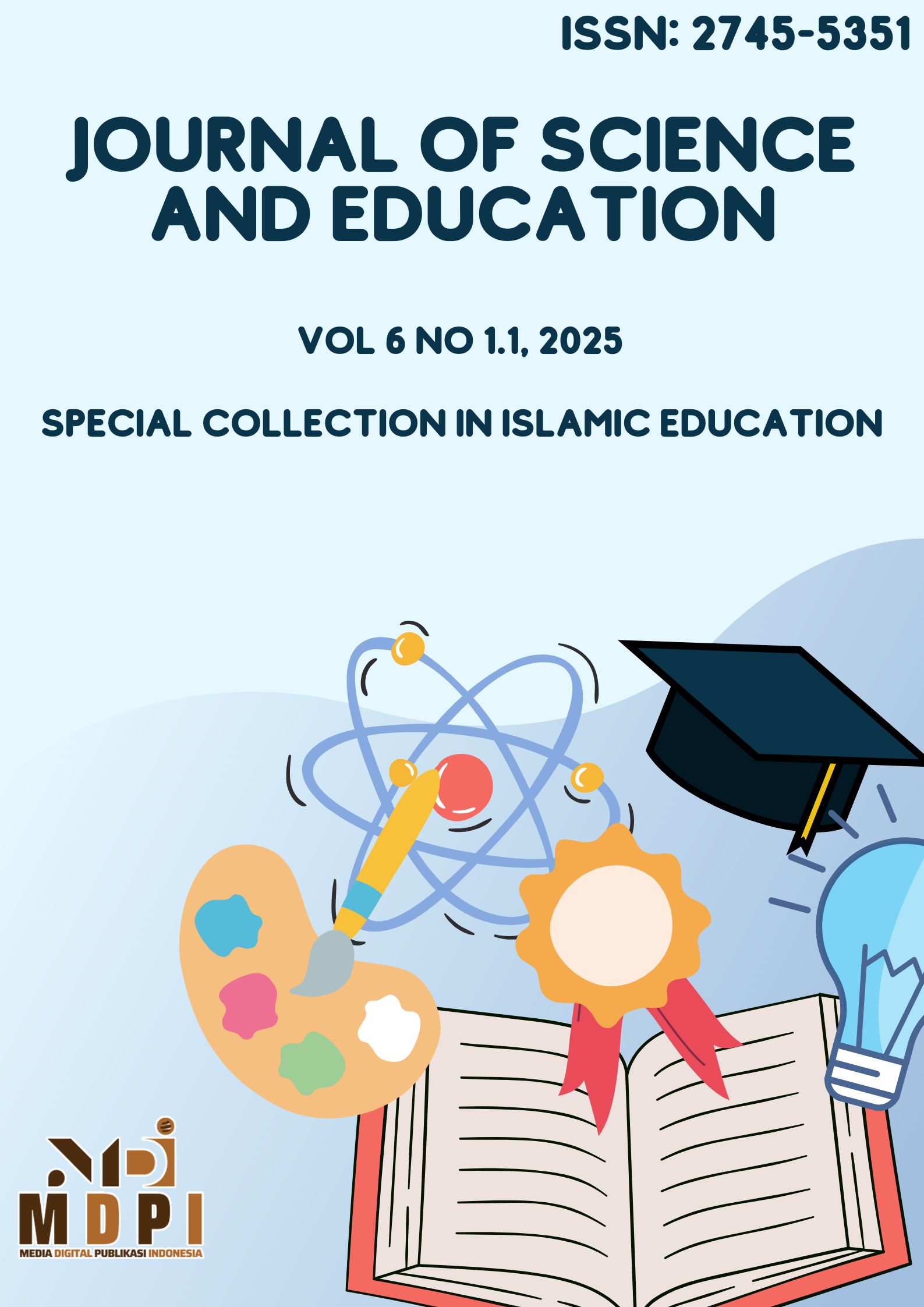The Efforts of Islamic Religious Education Teachers to Foster Students’ Religious Character through Religious Extracurricular Practices in Schools
DOI:
https://doi.org/10.58905/jse.v6i1.1.621Keywords:
Islamic Religious Education, religious character, extracurricular activities, habituation, moral reasoning, stakeholder collaborationAbstract
This study examines the efforts of Islamic Religious Education (PAI) teachers in fostering students’ religious character through religious extracurricular practices in two high schools with different contexts: SMA Karya Pembangunan 2 (general school) and SMA Muhammadiyah 4 (faith-based school) in Bandung City. Using a qualitative case study design, data were collected through in-depth interviews, participant observation, and document analysis, involving PAI teachers, extracurricular advisors, and active student participants. The findings reveal that SMA Karya Pembangunan 2 adopts a contextual and inclusive approach, integrating religious values with contemporary social issues and promoting tolerance through activities such as interfaith seminars. This model enhances students’ moral reasoning, empathy, and respect for diversity. In contrast, SMA Muhammadiyah 4 emphasizes structured habituation, including daily muhasabah, peer mentoring, and a tahfidz program requiring one juz memorization per year. This approach cultivates discipline, responsibility, and consistency in religious practice.Key supporting factors include stakeholder collaboration, notably in SMA Muhammadiyah 4 through home visit programs involving teachers, parents, and community members. The main challenge in SMA Karya Pembangunan 2 is the variation in students’ religious understanding, requiring differentiated instructional strategies. The study concludes that combining inclusivity with spiritual depth can offer a holistic framework for religious character development, aligning with the Penguatan Pendidikan Karakter (PPK) initiative.
Downloads
References
I. A. Hadi, T. Widarti, I. F. B. Hidayah, and M. Mahmud, “Educational transformation in the digital era: Innovative strategies and character challenges in creating the 21st century generation,” Turots J. Pendidik. Islam, pp. 990–997, 2024.
V. Sukmayadi and A. Yahya, “Indonesian education landscape and the 21st century challenges,” J. Soc. Stud. Educ. Res., vol. 11, no. 4, pp. 219–234, 2020.
M. R. Nasucha, K. Khozin, and I. Thoifah, “Synergizing islamic religious education and scientific learning in the 21st century: A systematic review of literature,” J. Pendidik. Agama Islam (Journal Islam. Educ. Stud., vol. 11, no. 1, pp. 109–130, 2023.
A. Hajar, “Navigating Globalization: Reforming Islamic Education for the 21st Century,” Sinergi Int. J. Islam. Stud., vol. 2, no. 1, pp. 53–65, 2024.
I. Ismail, “Character education based on religious values: an Islamic perspective,” Ta’dib J. Pendidik. Islam, vol. 21, no. 1, pp. 41–58, 2016.
P. Vermeer, “Religious education and socialization,” Relig. Educ., vol. 105, no. 1, pp. 103–116, 2010.
L. P. Barnes, Education, religion and diversity: Developing a new model of religious education. Routledge, 2014.
W. L. Wardekker and S. Miedema, “Identity, cultural change, and religious education,” Br. J. Relig. Educ., vol. 23, no. 2, pp. 76–87, 2001.
R. Stark and C. Y. Glock, American piety: The nature of religious commitment, vol. 1. Univ of California Press, 1970.
C. Hafizah, “Implementing student life regulations for religious character development in Islamic schools,” J. CENDEKIA Media Komun. Penelit. dan Pengemb. Pendidik. Islam, vol. 17, no. 01, pp. 69–86, 2025.
J. W. Creswell and V. L. P. Clark, Designing and conducting mixed methods research. Sage publications, 2017.
Adrias and A. Ruswandi, Desain Penelitian Kuantitatif, Kualitatif, dan Mix Method. Depok: Rajawali Pers, 2025.
R. K. Yin, Case study research and applications. SAGE Publications US., 2017.
R. K. Yin, Introducing the world of education: A case study reader. Sage, 2005.
M. Q. Patton, Qualitative research & evaluation methods: Integrating theory and practice. Sage publications, 2014.
A. Tashakkori and J. W. Creswell, “The new era of mixed methods,” J. Mix. Methods Res., vol. 1, no. 1, pp. 3–7, 2007, doi: 10.1177/2345678906293042.
Y. Lincoln and B. Guba, “Naturalistic inquiry. Beverly Hills: Sage Pulications.” Inc, 1985.
E. J. Tisdell, S. B. Merriam, and H. L. Stuckey-Peyrot, Qualitative research: A guide to design and implementation. John Wiley & Sons, 2025.
A. K. Shenton, “Strategies for ensuring trustworthiness in qualitative research projects,” Educ. Inf., vol. 22, no. 2, pp. 63–75, 2004.
M. B. Miles, A. M. Huberman, and J. Saldana, Qualitative Data Analysis A Methods Sourcebook, Third Edit. United States of America: SAGE Publications, Inc., 2014.
T. Lickona, Educating For Character. Jakarta: Sinar Grafika, 2012.
G. Gay, “Culturally responsive teaching: theory, research, and practice,” Choice Rev. Online, vol. 48, no. 05, pp. 48-2812-48–2812, 2011, doi: 10.5860/choice.48-2812.
A. Bandura, “Social foundations of thought and action,” Englewood Cliffs, NJ, vol. 1986, no. 23–28, p. 2, 1986.
L. Nucci and D. Narvaez, “Caring and Moral Education,” in Handbook of Moral and Character Education, Routledge, 2008, pp. 177–190.
J. Hattie, Visible learning for teachers: Maximizing impact on learning. Routledge, 2012.
J. L. Epstein, “School/family/community partnerships,” Phi delta kappan, vol. 76, no. 9, p. 701, 1995.
C. A. Tomlinson, “Differentiated Instruction in the Regular Classroom: What Does It Mean? How Does It Look?.,” Underst. Our Gift., vol. 14, no. 1, pp. 3–6, 2001.
J. A. Banks, An introduction to multicultural education, Sixth Edit. Pearson/Allyn and Bacon Boston, 2008.
Downloads
Published
How to Cite
Issue
Section
License
Copyright (c) 2025 Junaedi, Ahmad Sukandar

This work is licensed under a Creative Commons Attribution-ShareAlike 4.0 International License.

















